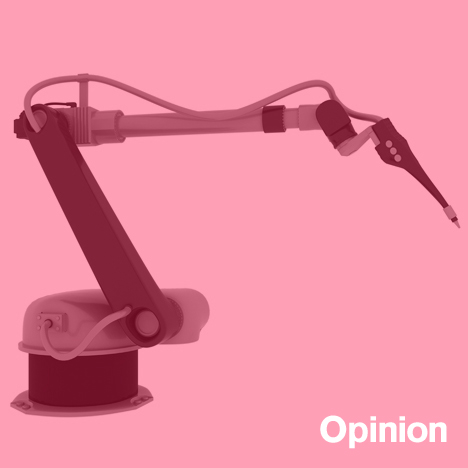
"Sorry green design, it's over"
Opinion: in a special Valentine's column, Dezeen editor-in-chief Marcus Fairs explains why designers have dumped dowdy green design in favour of glamorous robots.
Tech has killed green. Until recently the design world was on a mission to save the planet; now it seems enthralled by gadgets. Adjectives like "sustainable" and "eco" have been usurped by upstarts such as "smart" and "hacked". The cardboard furniture glut of recent years has disintegrated; recycling has gone to landfill.
It's not long since design-school grad shows were dominated by the hand-made, the low-tech and the organic; now it's all embedded sensors and connected devices. Design fairs have ditched the obligatory maker or two turning discarded pop bottles into chandeliers - or knitting seaweed into cushions - for 3D printers and robots. Collaborations with Vietnamese basket weavers are out; Raspberry Pi mashups are in. In Milan this year the young Dutch contingent will no doubt have stopped serving wholesome hyper-local snacks and will instead be touting lab meat and printed biscuits.
Green design felt right at the start of the economic crisis: it sought to replace over-indulgence with frugality, served with a side order of punishment for our wickedness. Penal minimalism was all the rage: spartan furniture made of ethically sourced timber that was so good for you, it hurt.
Natural was good, artificial was bad. Soon we'd all be growing our own organic food on our city balconies and installing complex plumbing to irrigate it with our bathwater. We'd be going off-grid, hooking up to domestic wind turbines and pondering the plausibility of upcycling under our solar-powered lamps.
It was a romantic vision, but a pessimistic one. It demanded we atone for resource scarcity by making do with less. It suggested we undo the damage caused by rampant consumerism by engaging in a paradoxical and ill-defined un-consumption. We would buy our products only once, and they would last us forever, whether we liked it or not.
But sustainability turned out to be unsustainable. We just didn't have the time; we couldn't afford to be green. We thought the products looked ugly. We didn't enjoy the preachiness or the guilt.
But most of all we got seduced by tech. iPads! Plasma TVs! Replicator 2s! Drones! Anything, as long as we can plug it in or put batteries in it. Anything, as long as it has a touchscreen or makes a reassuring beeping sound.
Even green design blogs such as Inhabitat and Treehugger have experienced technophiliac mission creep and now cover smartphone-powered satellites and 3D-printing on the moon as well as passive ventilation.
Design movements come in regular waves, of course. In my fifteen years as a design journalist I've witnessed the tail end of the Dutch conceptual boom around the millennium; the return of decoration in the early noughties, spearheaded by Marcel Wanders and Tord Boontje; and the design-art bubble of the mid-noughties. These are just a few of the fads that have swept through design.
But green design felt different as it sought to both comment on, and provide solutions to, a more profound set of questions than designers usually address. It felt too important to be a passing phase.
In truth, green didn't completely die. Some aspects of it became so ubiquitous that they vanished from view. Many products today use less packaging, less embodied energy and fewer nasty chemicals than they did a decade ago. They just don't shout about it so much. Green became normal.
But green's message did not adapt and it ran out of steam. It fell foul of the law of diminishing returns: it's easy to make the first cut in your carbon footprint, but every subsequent one gets more difficult. And because the back-to-nature, made-do-and-mend doctrine supped from a limited gene pool of visual stimulus, it became an aesthetic trap. Once you've hewn furniture from raw timber, there's not much further you can go.
Technology however is intrinsically optimistic: each new development, each new device brings the promise of a new future. Each new way of arranging atoms or bits opens the door to a new solution cloaked in a new form. And since these elements are infinitely configurable, technological development is more sustainable than sustainability, since it will never run out of ideas.
It's harsh to break the news on Valentine's Day but here it is: sorry green design, it's over. It wasn't really going anywhere. And we've fallen in love with a robot.